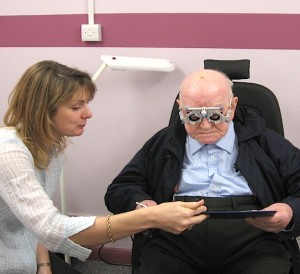Helping Your Low Vision Patients

There is a growing category in the optical business that is somewhat disregarded and certainly somewhat misunderstood. One in 28 Americans age 40 and above suffers with low vision. That number will grow over the next 20 years due to the fact that approximately 10,000 baby boomers turn 65 every day. It is estimated that more than 39 million Americans have low vision or a disorder that can lead to it.
Eyecare Business Magazine first referred to low vision as “the most underserved category in optical” back in the early ‘90s. Twenty years later, not much has changed except that the growing number of patients who suffer has increased as the population increases.
These patients, for the most part, are being told that “nothing can be done” or they’re not being seen at all. While it’s true that there is no cure, there are solutions that can help people improve quality of life, such as daily living aids, low vision devices and sophisticated spectacles.
What Causes Low Vision?
Low vision is often caused by eye diseases, such as:
- Cataracts – more than 20 million Americans
- Diabetic Retinopathy – 7.6 million Americans
- Glaucoma – 3 million Americans
- Age-Related Macular Degeneration – 2.07 million Americans
According to The Vision Council, up to 80% of cases dealing with visual impairment are considered preventable. Through annual comprehensive eye exams, an eye care provider can diagnose and treat many eye conditions early in the disease progression. In many cases, timely care can delay or prevent vision loss.
What Can Eye Doctors Do?
Communication with your patients is crucial. Helping them to understand that proper diagnosis and early treatment are key strategies to prevent or delay vision loss. Even more important, your younger patients will appreciate your advice on avoiding visual impairment issues in the future, such as the importance of wearing sunglasses, potential High-Energy-Visible (HEV) light* and UV light damage.
Dr. Richard Shuldiner, founder of the International Academy of Low Vision Specialists offers three suggestions when dealing with patients complaining that print is just not clear enough:
- Increase Illumination – Suggest a table or gooseneck lamp so the light can be aimed at the desired surface. Companies like Ott-Lite make lamps designed specifically for those suffering with low vision.
- Prismatic Eyewear – Recommend patients increase their add with prismatic half eyes. These reading glasses are unique in that users can enjoy two different lens powers of magnification with just one pair.
- Refer to Low Vision Optometrist – If necessary, send your low vision patients to a low vision specialist, ODs who have been trained specifically for low vision patients. To find a low vision specialist near you, visit http://whatislowvision.org/find-a-low-vision/.
Dr. Shuldiner also gives this advice when dealing with low vision patients:
Don’t say, “This is as strong as possible.” For near, you can ALWAYS increase plus for more magnification.
Don’t say, “There is nothing more that can be done.” It may be true medically, but not visually until a qualified low vision doctor works with the patient.
Low Vision Solutions
There are options available for both low-vision patients and their caregivers. Tools and technologies are becoming available today that are more powerful and more affordable than ever before. With a variety of products on the market, from illumination and magnification to electronic aids, patients with any type of vision loss or impairment can enjoy improved quality of life.

From The Vision Council: https://www.thevisioncouncil.org/sites/default/files/VC_LowVision_Report2015.pdf
There is a growing population of patients with low vision who are facing serious quality of life issues. Instead of the all-to-common response that there’s nothing that can be done, perhaps there are some suggestions and encouragement eye doctors can offer. Certainly, by encouraging those patients who are approaching the age where eye disease starts to become a reality to get their annual eye exam is a start. Then, there might be an entirely new market where an eye doctor could provide low vision accessories and low vision aids to help patients who already deal with low vision.
To learn more about Low Vision, visit www.whatislowvision.org.
*See our related blog post, "Harmful Blue Light: What's All the Fuss?"
